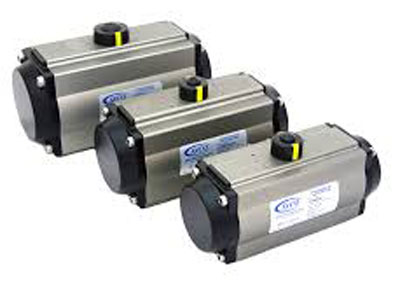What Powers A Pneumatic Actuator?
Key Takeaway
A pneumatic actuator is powered by compressed air or gas from an external source, most commonly dry, clean air. The air enters a chamber, building up pressure, which then creates mechanical motion. This motion can be either linear or rotary, depending on the actuator’s design.
Pneumatic actuators are widely used in automation and control systems to reduce the need for manual intervention. They are ideal for tasks like automatic modulation and emergency shutdowns. A single air compressor can power multiple actuators, making it an efficient choice for systems with many valves. There are different types of pneumatic actuators, including linear actuators, which use pistons for straight-line motion, and rotary actuators, which generate torque for rotating movement.
The Role of Compressed Air in Pneumatic Systems
Compressed air is the primary energy source for pneumatic actuators. It acts as the medium that transmits power to create motion, whether linear or rotary.
When air is compressed, it stores potential energy. This energy is released into the actuator through control valves, creating the force needed to move a piston, diaphragm, or vane. The compressed air’s ability to expand and exert pressure is what drives the actuator’s operation.
The use of air as an energy source offers several advantages. It’s clean, readily available, and safe, especially in hazardous or explosive environments where sparks from electrical systems could pose a risk. These characteristics make pneumatic actuators ideal for industries like food processing, healthcare, and manufacturing.
Understanding the role of compressed air is fundamental for engineers designing pneumatic systems, as it directly impacts the actuator’s performance and reliability.

How Pressure and Flow Impact Actuator Performance
Pressure and flow are critical factors in determining the performance of pneumatic actuators. Together, they dictate the force, speed, and efficiency of the system.
Pressure refers to the amount of force exerted by the compressed air. Higher pressure levels increase the force generated by the actuator, enabling it to handle heavier loads. However, excessive pressure can strain components, leading to wear and potential failure. Engineers must ensure that the pressure matches the system’s requirements for optimal performance.
Flow, on the other hand, determines how quickly air moves through the system. A higher flow rate allows the actuator to respond faster, making it ideal for high-speed operations like material handling or packaging. Conversely, low flow rates can slow down the actuator’s motion, reducing system efficiency.
Balancing pressure and flow is essential. Pressure regulators, flow control valves, and proper pipeline design play a significant role in maintaining this balance, ensuring that the actuator operates smoothly and efficiently.
Components That Drive Pneumatic Actuators
Several key components work together to power a pneumatic actuator, ensuring reliable and efficient operation. These components include air compressors, storage tanks, pipelines, control valves, and the actuators themselves.
The air compressor is the starting point of the system. It compresses atmospheric air to the desired pressure, storing it in tanks for future use. The storage tanks ensure a steady supply of compressed air, even during high-demand periods.
Pipelines and hoses transport the compressed air from the storage tanks to the actuator. These must be designed to minimize pressure drops and air leaks, which can impact system performance.
Control valves regulate the direction, pressure, and flow of the air entering the actuator. They are crucial for controlling the actuator’s motion and ensuring precision in operations.
Finally, the actuator converts the compressed air into mechanical motion, performing tasks like pushing, pulling, or rotating components. Each component plays a vital role in driving the system, and engineers must design and maintain these elements carefully to ensure optimal performance.
Energy Sources for Generating Compressed Air
Compressed air used in pneumatic actuators is typically generated by air compressors, which draw energy from various sources. The choice of energy source depends on the application and operational requirements.
Electric-powered compressors are the most common, offering efficiency and reliability for industrial applications. These compressors are available in various sizes and capacities, making them suitable for small workshops and large manufacturing plants.
Diesel and gasoline-powered compressors are used in remote or outdoor locations where electricity is unavailable. They provide portability and high output, making them ideal for construction sites and field operations.
Renewable energy sources, such as solar and wind, are becoming increasingly popular for powering air compressors in sustainable systems. These options align with industries aiming to reduce their carbon footprint.
Selecting the right energy source is critical to ensuring a consistent and efficient supply of compressed air, which directly impacts the performance of pneumatic actuators.
Factors Influencing the Efficiency of Power Supply
The efficiency of the power supply in a pneumatic system affects the overall performance of the actuator. Several factors come into play, including air quality, system design, and maintenance practices.
Air quality is crucial. Contaminants like moisture, oil, and dust can reduce the efficiency of compressed air, leading to wear and tear on components. Filters, dryers, and lubricators are essential for maintaining clean and dry air.
System design also plays a significant role. Properly sized pipelines, valves, and actuators ensure that air pressure and flow are maintained without unnecessary losses. Engineers must carefully plan the layout to minimize leaks and optimize airflow.
Regular maintenance is vital for preventing issues such as air leaks or malfunctioning compressors. A well-maintained system not only improves efficiency but also extends the lifespan of the components.
By addressing these factors, engineers can enhance the efficiency of the power supply, ensuring that pneumatic actuators operate at their best.
Conclusion
Pneumatic actuators are powered by compressed air, with pressure and flow playing critical roles in determining their performance. Components like air compressors, storage tanks, and control valves work together to ensure a steady and efficient power supply.
For engineers, understanding how pneumatic systems are powered is key to optimizing their design and functionality. With proper system design and maintenance, pneumatic actuators can deliver reliable and efficient performance across various industrial applications.
